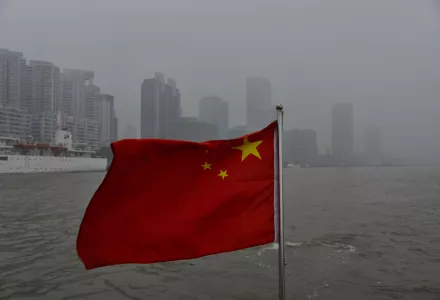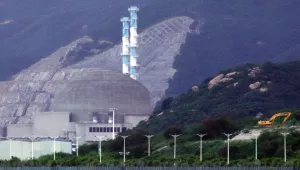
Aiming for Zero Carbon Emissions in China
by Jonathan Edel
As the single largest greenhouse gas emitter in the world and the source of almost 30 percent of the CO2 released into our atmosphere, China faces an enormous challenge in reaching its goal of zero or negative emissions—known as deep decarbonization.
Henry Lee, Director of the Environment and Natural Resources Program (ENRP), and Dan Schrag, Co-Director of the Science, Technology, and Public Policy Program, head a team of researchers from the U.S. and China who have been examining China’s work in achieving deep decarbonization in the People’s Republic. The team plans to publish its findings in a book to be released in 2019.
China has pledged to stabalize its carbon emissions by 2030 and has rolled out an ambitious program to reduce emssions of conventional pollutants. The book will focus on actions China can take now that will position the country to significantly reduce its carbon emissions in the post-2030 period.
China’s government has offered incentives and adopted policies geared toward lowering emissions. Ambitious renewable installation targets and the introduction of a tradable performance program in the electricity sector implemented in 2018 are among the most salient of these measures. At the core of ENRP's research is an examination of how China can implement possible frameworks for deep decarbonization, even if the relevant technology has not yet reached its full potential.
“This project is not looking at the next five years, but rather the next 30 to 50 years,” Lee says.
The ENRP team’s upcoming book, with sections written by Lee and Schrag and by research fellows Wei Peng, Qinyu Qiao, and Michael Davidson—along with former research fellows Zhimin Mao and Pu Wang and Professor Matthew Bunn—will offer a broad analysis, focusing on policy questions and also offering some insight into sustainable technologies.
Wei Peng
China’s Smog: Danger and Opportunity
by Jonathan Edel
To research fellow Wei Peng—and to China’s government—a major air pollution crisis in 2013 came as a call to arms against China’s toxic air quality—with profound implications for its energy use and carbon footprint.
“Driven by pollution concerns, China has started to curb its coal consumption and emissions,” Peng believes. “It’s a golden age for China’s environmental policymaking.”
The thickening smog in China, she believes, represented danger but also opportunity. China’s reaction to the crisis could be seen as an initial step down a path to more comprehensive decarbonization.
When she was an undergraduate studying environmental science at Peking University of Beijing, Peng recognized that in researching pollution, she was examining the symptoms of policy but not the underlying causes: “Air pollution is an end problem; government policy is what can actually make change happen.”
“We’re not choosing tech options,” Peng says of her ENRP team’s research into China’s decarbonization challenges and opportunities. “We are thinking about high level strategies as foundations of change. It’s not the marginal CO2 emissions that matter, it’s the cumulative emissions—from now to 2030, 2050, and beyond.”
From infrastructure placement to balancing power costs with industrial stability, China has some sizable hurdles to overcome in the near and long term. In this context, an understanding of location is paramount.
“How policy is formed and implemented is very different in the U.S. as compared to China,” Peng says. “If China’s government wants to do something, they can get it done quickly. This is why for China we need to understand the synergies and tradeoffs between different policies.”
Along with the pragmatic desire to reduce pollution, the crisis has shifted a cultural paradigm, Peng notes. As rapid development has continued to lift people out of poverty, millions have been able to look beyond survival and see the value of protecting their air, water, and land.
“It’s not like China wasn’t polluted before,” Peng adds. “But as people get richer, they realize that there are other important things in their life, such as clear air and cleaner water.”
Michael Davidson
For a Greener China, its Growth Model Must Change
By Christian Gibbons
Since Michael Davidson’s first visit to China 10 years ago as a Fulbright Scholar, the Middle Kingdom has continued to fascinate him.
China’s reliance on a centrally planned economy has served it well up to this point, Davidson says, but it is beginning to provide diminished returns. Now, from his position as a post-doctoral research fellow with the Belfer Center’s Environment and National Resources Program, Davidson is exploring the complications and tensions inherent in one of China’s current challenges: its attempts to decarbonize.
“With decarbonization, every place is unique. Because it’s such a complex phenomenon, every country is going to do it differently,” he explains. “China has actually one of the biggest challenges in decarbonization and scaling up renewable energy.”
“Climate change is consistently mentioned in [China’s] policy documents,” he says. “There is no denier community in the Chinese government.” This is reflected in the rapid, substantial effort that the Chinese government has made to increase usage of renewable energy—an effort that, according to Davidson, has already produced results in excess of their expectations. At the same time, however, the inflexibilities of China’s centrally planned economy are showing more and more.
“They need to move toward less energy-intensive production, to reduce waste, to reduce costs, and to support the labor force that they have,” Davidson says. “There is a strong need to increase efficiency in the economy, because China’s traditional growth model just won’t work going forward.”
China will probably have to significantly readjust its approach if it wants to continue to cut emissions, Davidson believes. For this reason, China’s experience can provide important lessons for other societies seeking to rely more heavily on clean energy sources.
“A key challenge now is to make sure that other countries looking at the Chinese success in developing its wind and solar industries think about this question: What are the institutions for growing renewable energy—not for going from 0 to 2 percent, but from 2 to 20 percent?”
Qinyu Qiao
The Role of New Energy Vehicles in China
By Celia Carbone
Along with Henry Lee, research fellow Qinyu Qiao researches and analyzes the foundations for decarbonizing China’s transport sector. Qiao focuses on the use of “zero” carbon energy sources in passenger electric vehicles.
In China, Qiao says, it is best to look at decarbonization as a long-term transition yielding results in the next 50 years.
For instance, of the 27 million vehicles produced in China in 2017, only about 500,000 were electric, and most of these were extremely small vehicles. While this fraction of new energy vehicles has little impact at this time, he says, the popularity of electric vehicles is on the rise in China. China’s changing policies will also increase this number.
“Electric vehicles are 35 percent cleaner than internal combustion engine vehicles, but 35 percent is still not enough,” Qiao adds.
According to China’s EV100, the leading conference of the new energy vehicle industry, there will be eight million electric vehicles on the road in 2030, therefore GHG emissions will be reduced by 830 million tons. This is based on the assumption that the emissions factor (life cycle GHG emissions per unit of energy consumption) will not change. Qiao’s research, however, shows that the reduction will likely be even greater due to decreasing emissions factors from renewable energies.
Electric vehicles are perceived as zero-emission vehicles because they do not emit during the use stage. However, Qiao notes, that perception is “unfair” because power generation is not zero-emission.
Electric vehicles do not provide as many environmental benefits when manufacturing and recycling stages are also considered, he explains, since significant emissions are released in the process of manufacturing the battery. So those factors must also be considered and confronted in China’s attempts to decarbonize.
“China is encouraging the use and manufacturing of new energy vehicles,” Qiao says. That fact can be seen in new policies that include a dual credit regulation requiring vehicles to meet new fuel consumption standards either by altering traditional vehicles or producing new energy vehicles.
These new standards, Qiao says, will force the manufacturers in China to produce more new energy vehicles and that will increase progress toward decarbonization.
"Decarbonization Initiatives in China." Fall/Winter 2018-2019 Belfer Center Newsletter. Belfer Center for Science and International Affairs, Harvard Kennedy School, Summer 2018.










